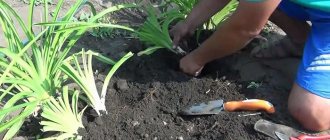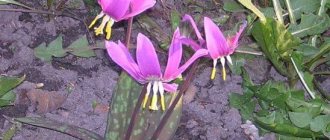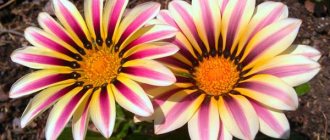Most often, the presence of a shady area on a summer cottage looks like a scourge for an inexperienced gardener. It is best to grow herbs in such an area that respond positively to shade. Unfortunately, such a beautiful flowering plant as Tiarella has not yet received its fame, but in vain.
The Tiarella flower acts as an evergreen ground cover plant, which is ideal for growing in a shady place. Most of the varieties that belong to the Saxifraga family are perennial plants, but there are also those that are grown in our country as annual plants. in the wild, the plant can be found in various regions, for example, in the climate zone of the warm states of North America. Some species can be found in Korea and China. There are varieties that grow well in Japan.
Tiarella is a herbaceous plant that is easy to grow. The plant is unpretentious in its care, tolerates cold well, and loves shady places. In our country, perennial plants are suitable for growing in regions where there are warm, snowy winters, and are also well suited for growing at home.
Description: varieties and varieties of tiarella
Tiarella or tiarka is a perennial evergreen herbaceous plant of the Saxifraga family from North America.
Its varieties are distinguished by their beautiful appearance during flowering. During this period, tubular or cone-shaped candle inflorescences are formed on the peduncles. Tiarella leaves also look attractive. In the fall, after the plant has flowered, it looks great as a lawn substitute. Tiarka characteristics:
- height of peduncles - up to 70 cm, leaf cover is about a third lower;
- the leaves consist of three dissected parts, in some varieties - of one;
- leaf shape - carved, lace;
- size - up to 15 cm in length, up to 10 in width;
- leaf color is juicy green, may have dark lilac-brown veins, stripes and core;
Tiarella has unusually colored leaves
- petiole length - 20 mm, only one leaf usually grows on the stem;
- inflorescences are paniculate, located at the top of the stem;
- the flower is bell-shaped, with petals up to 3 mm in length.
Tiarella blooms for about a month. In different varieties of plants, it may occur for different periods from late spring to late summer. In hot weather, flowering time is shortened. After wilting, the flower forms an oblong capsule with ovoid seeds.
The plant does not have many ornamental species:
- unifoliate;
- trifoliate;
- multileaf;
- Wherry;
- cordifolia.
Tiarella cordifolia
The latter is most in demand among domestic flower growers. This variety has excellent frost resistance and survival in open ground. The heart-shaped tiara forms inflorescences, close in shape to a cylinder, of white and pink flowers. It blooms in early summer. The leaves change color throughout the year: from pink in the spring, to green in the summer and bronze-scarlet in the fall.
Advice. Tiarka also has many beautiful and diverse hybrid varieties. For example, Crow Feather, Iron Butterfly, Pink Skyrocket or Dark Eyes. They are all unpretentious to care on the site. Therefore, you can choose based solely on the photo.
Popular varieties of tiarella
There are many varieties of tiarella, each of which has its own characteristics and specifics of cultivation.
Tiarella cordifolia is a popular and widespread variety that is a perennial plant with creeping stems. The leaves are heart-shaped, rounded, collected in neat rosettes. Flowering begins in early May and lasts up to 5-6 weeks.
Varieties popular among gardeners:
- Tiarella Neon Lights is a variety of heart-shaped tiarella. This species is characterized by large leaf size and snow-white flowers with dark purple veins.
- Black Snowflake is an equally common variety, distinguished by the light pink color of the inflorescences and the carved shape of the leaves with a glossy surface.
- Spanish Cross is an interesting variety that has pink inflorescences that gradually acquire a snow-white hue.
- Tiarella Pink Skyrocket is a perennial plant up to 30 cm high with conical inflorescences consisting of small pink flowers. The foliage is light green, reminiscent of maple, with purple centers.
- Jeepers Creepers is an unusual variety of tiarella that has lacy, light green foliage that turns a deep purple in early fall.
Tiarella Timbuktu - this variety is distinguished by rosettes up to 35 cm long. It has an unusual leaf color - green with purple veins and a burgundy center. The inflorescences are fluffy and paniculate, consisting of small pale pink flowers.
Tiarella: planting a plant
It is better to choose at least a slightly shaded place for the tiara. Under the summer sun, the crop will also develop normally, but will lose its decorative value: the leaves run the risk of burning out, and the flowers will fade faster.
Plants are planted with ready-made seedlings. Tiarella develops best in slightly alkaline or neutral soil. It is not advisable to choose a place for planting in a lowland or with close groundwater. The rhizome of tiara is prone to rotting in conditions of high humidity.
Advice. The soil on the site should retain moisture well after watering, be light and loose.
Boarding procedure:
- dig a hole one third deeper than the height of the root;
- lay drainage at the bottom - pebbles or pebbles mixed with sand;
- add ash on top in combination with complex mineral fertilizer (nitroammofoska);
- water lightly;
- deepen and bury the seedlings.
Types of tiarella with names and photos
Several species are grown in cultivated floriculture.
Tiarella cordifolia
Tiarella cordifolia planting and care photo in the garden
Up to 20 cm tall, with star-shaped white or cream flowers. It multiplies and grows quickly. It stands out for the beauty of its leaves - graceful, slightly pubescent, on long petioles. They overwinter well, die off only in May, and new ones immediately appear to replace them. After flowering, the rosettes throw out numerous creeping tendril shoots, which form throughout the season and take root in each node.
During a season, one plant can form about 20 new ones. Quite quickly it conquers the surrounding free space, resulting in a dense cover. There are several interesting variegated varieties with bronze or purple spots and prominent edges or veins. Relevant use for carpet plantings under bushes and trees.
Tiarella wherryi Tiarella wherryi
Tiarella wherryi Tiarella wherryi photo in the garden
Up to 30 cm high, blooms from June to September with pinkish flowers. The bushes do not sprout and grow less actively. It is less resistant to winter cold and requires additional shelter. Its leaf blades are more decorative, unusually and effectively colored, and have a contrasting pattern in the center of the leaf blade.
Tiarella polyphyiia
Tiarella polyphyiia flower photo
It has peduncles with pinkish-cream flowers up to 50 cm. This species is not frost-hardy enough and requires special measures for preservation in winter.
Tiarella trifoliata
Tiarella trifoliata growing and caring for flowers photo
It has a persistent and hardy character and is considered the ancestor of many modern varieties. Squat bushes with carved leaves grow quickly on loose forest soils, fluffy flowers are collected in spectacular plumes of inflorescences. Easily spreads by self-seeding.
Tiarella unofoliata
Tiarella unofoliata flower photo
Large wild species. It is successfully grown by amateur flower growers in many regions of our country. Tolerant to adverse conditions, frost-resistant plant.
Tiarella care
Growing tiara and caring for it in open ground is simple, but still has several features. Take them into account at the planting stage:
Tiarella does well in the shade
- The plant needs abundant watering. At the same time, keep the soil loose.
- Since tiara is an evergreen crop, in March, when the sun is warm but the soil has not thawed, the plant may suffer from a lack of moisture. In this case, sheltering from the rays or watering the entire bush with warm water will help.
- During flowering, pick off spent flowers to avoid self-seeding. Tiarka is very prolific, and in a couple of seasons it can take over more area than you allocated to it.
- All varieties of tiara are cold-resistant to one degree or another. But it’s better to cover them for the winter with non-woven material.
- Plants older than 3-4 years necessarily need winter protection. The base of the stem is exposed. Bare roots are hilled up and mulched in the fall.
- Aged bushes look unsightly due to exposed roots. They are either covered with mulch or dug up and divided for propagation.
Advice. The plant variety should still be chosen taking into account the characteristics of winter in your region.
Reproduction of tiarella by dividing the bush
Tiarella in the garden photo
Tiarella is propagated by dividing overgrown bushes every 3-4 years. The best results are obtained when dividing before flowering begins: before the onset of persistent cold weather, such bushes become completely independent and overwinter well.
- Well-developed bushes are carefully divided into separate parts with a growing point, which are rooted in light nutritious soil to which peat can be added.
- For propagation, you can use cuttings with rosettes - they take root easily and grow all summer in a shaded place. They should be given special attention during their first winter by providing light shelter.
Tiarella: plant propagation
The usual practice for tiara is vegetative propagation in the spring. A specimen with the exposed bottom of the rosette should be dug up and divided into parts with a sharp knife. It is important that each fragment has several branches. Dig holes about 30x30 cm for the divisions and fill them with fertile soil with a mixture of fertilizers as when planting.
You can propagate using rosettes that have at least a couple of young leaves. Cut one and root it in sand or sand-peat substrate. Shade and do not forget to water. This is also a spring procedure.
Tiarella should be covered for the winter
Tiarella is also propagated by seeds. Planting should be carried out in March or April in open ground without preliminary preparation of planting material. Simply mix the seeds with sand and scatter them over the surface of the ground. Care after germination comes down to regular moistening. Tiarka, under minimally favorable growing conditions, can reproduce by self-sowing.
Attention! The new plant will retain the characteristics of the mother bush only through vegetative propagation.
Growing a plant
Reproduction
For reproduction, one of three methods is used:
- seeds;
- dividing bushes;
- cuttings
All methods are simple and effective, but it must be taken into account that when propagated by seeds there is no guarantee that the new plants will retain the varietal characteristics of the mother plant. In cold climates, seedlings are grown from tiarella seeds.
Seedlings are planted after they get stronger. The best time for sowing is the end of February. Small containers are filled with nutritious, light soil. The seeds are scattered over the surface, covered with sand, sprayed with a spray bottle, covered with film, and placed in a warm room.
To prevent the seeds from rotting and to get enough air, the cover is removed for a short time every day. The seedlings do not need shelter. Care comes down to regular watering. After growing 3 or 4 leaves, the seedlings are pricked.
This work must be done carefully, since the roots are very thin. The best option is transshipment along with a lump of soil. In the future, only watering is needed. Hardening begins in clear, warm weather. To plant in the ground, you need to choose a warm day without rain.
In temperate climates, seeds can be sown in the ground in April. Due to their very small size, they are usually mixed with sand and buried 1.5-2 cm. For backfilling, it is better to use sand; the bed should be covered with film. The cover is removed after germination.
If the seedlings are close together, it is necessary to thin them out (there should be 5-7 cm between plants). Watering is required if the soil is dry. Tiarella is planted in a permanent place at a height of 20-30 cm.
It is easier to use division of bushes for propagation. This work should be carried out after flowering or in early spring. Adult tiaras are dug up and divided into several parts.
It is important that each of them has strong roots and points for growth. The distance between new bushes is 40 cm; after planting, they need to be watered.
The cuttings of this culture are rosettes. They are taken from adult bushes and planted after treatment with a growth stimulator. When planting tiarella in a well-lit place, shading is required; for the first winter, the bushes need to be covered.
Agricultural technology
To enhance flowering, tiara is planted in fairly large bushes immediately after the snow has melted. Frosts and temperature changes are not scary for this plant.
The place should be chosen in partial shade or shade (under bushes, trees). Under the rays of the sun, this plant loses its decorative properties. The exception is varieties with variegated leaves. They require lighter areas, but direct sunlight is also contraindicated.
A couple of weeks before planting, the area needs to be dug up, weeds should be removed along with the roots, and aeration should be increased on clay and loam by adding sand and peat. High acidity requires ash. The distance between planting holes is approximately 25 cm.
Tiarka loves organic matter, so it is advisable to add compost to each hole in addition to drainage (sand, broken brick, expanded clay).
The seedlings are placed in the holes, after straightening the roots. After planting, the bushes are watered, the soil is mulched with dry leaves or sawdust, and shading is required in open areas.
Tiarella: combination with other plants
In open ground, tiara looks great in combination with heucheras, ferns, and mahonia. Her ensemble with barberry, hostas, rhododendrons, spirea and other crops is successful. The crop is planted near large trees and in colorful heather compositions.
The advantage of tiarella is that it looks equally good both in well-groomed cultivated corners and in undeveloped areas of the garden.
Description of tiarella and photo
Tiarella in landscape design photo mixborder
Tiarella is a low-growing evergreen plant whose leaves turn red or bronze in winter. Belongs to the saxifrage family. Its five-lobed leaves have an attractive contrasting pattern. In summer it blooms with a spike-shaped inflorescence of small delicate flowers. This is a stable, fast-growing, unpretentious plant for creating dense soil cover in shady corners of garden plots.
The flowers look like little turbans - hence the name. It is native to the coniferous forests of eastern North America. There, these plants form an evergreen continuous carpet or individual clumps under the shady forest canopy.
Growing tiarella
Tiarella, as a forest plant, loves dense shade or partial shade. But some variegated varieties require a little more sunlight to fully develop their decorative qualities. In the sun, tiarella will grow smaller, its flowering time will be half as long, and the leaves will lose their bright color.
This plant easily tolerates drought and severe frosts, grows quickly in dense shade, so it is often planted instead of a lawn.
To encourage flowering and avoid self-seeding, you must constantly remove wilted flowers. If you miss this moment, the tiarella will very quickly capture a large territory.
Despite its drought resistance, the plant must be watered regularly and abundantly. This will give the plant bushes additional strength for lush growth, abundant flowering and brightly colored leaves.
Description of the plant
Tiarella cordifolia is a perennial creeping shrub of the Saxifraga family. Under natural conditions, this winter-hardy plant grows in the snow-capped mountains of North America.
Tiarella cordifolia is a perennial flower whose leaves are collected in a round rosette. The leaf blades are heart-shaped, divided into 5-7 lobes and located on long petioles. The upper part of the leaf is decorated with bronze-colored veins. With the onset of frost, the leaves of the tiara change color and become red.
The inflorescence has the shape of a panicle and is formed on a peduncle up to 20 centimeters long. The flowers are delicate, graceful, yellow-cream in color. Outwardly, they resemble stars. Flowering begins in May. The flowering plant will look very elegant. The inflorescences, consisting of many small flowers, look like thin lace.
At the end of the flowering period, fruit boxes filled with small seeds are formed. The formation of new shoots of cordifolia occurs throughout the entire period of active growth. Young shoots take root in each internode.
Tiarella is often used for planting in acidic soils. The plant feels good next to tall trees and shrubs. Tiarella helps maintain soil moisture.
Wintering tiarella
Before the onset of severe cold, the area where tiarella grows is cleared of the remains of annual plants, weeds and loosened. The soil around the plant is additionally covered with peat or fallen leaves. This is done so that the exposed roots of adult tiarella bushes are not damaged by low winter temperatures. Plants of the first year of life must be additionally covered with non-woven material so that the plant has time to firmly establish itself in the soil. In spring, the winter shelter is completely removed only when the threat of frost has passed.
Fertilizer for tiarella
Fertilizers are usually applied twice - at the beginning of the growing season and when flowering ends. Use complete mineral fertilizer at a rate of 20 grams per square meter of area.
But other means can also be used. For example, before flowering, you can add nitroammophoska, which will provide not only nitrogen, but also phosphorus, which the bush needs to form flowers.
A full tablespoon of fertilizer is diluted in a 10 liter bucket of water - this volume of liquid is enough to spill a square meter of area. Tiarka responds well to organic matter.
General information
If we talk about the botanical description of tiarella, then it is herbaceous, 10-80 cm in height, the roots are weak, but they grow quickly in loose, fertile soil. Suitable for growing by inexperienced gardeners and summer residents who do not have enough time for care. Can be used as a ground cover plant.
Green “lace” leaves are simple (less often complex), carved, consist of three or five plates, the center is purple, pink, lilac, brown, light green.
The length of the cuttings is no more than two cm. During frosts, the color changes to bronze-red.
The panicle inflorescences on the tops of the shoots are fluffy, small flowers in the form of tubes or small cones. The color is white or pink, the beginning of buds depends on the variety, the flowering period is up to 35 days, if it is not too hot.
The fruit has the shape of an oblong box, the seeds are oval. The decorative effect does not decrease after flowering ends.
Types and varieties
The following types of tiarella are grown in culture:
- cordate;
- Wherry;
- Timbuktu;
- multileaf;
- trifoliate;
- unifoliate.
Heart-shaped tiara is groundcover , perennial, maximum height 30 cm, heart-shaped, openwork leaves. Inflorescences are panicles, small, cream flowers. Rapid growth is due to the formation of rosettes and the rooting of creeping shoots, which are sometimes called tendrils.
This variety of tiarka quickly takes up all the available space; outwardly, the planting looks like a carpet.
The foliage is pink in spring, green in summer, red in autumn, closer to bronze. The buds bloom in June, the flowers are pink, almost white. Resistance to low temperatures allows you to winter without shelter.
Tiara Wherry is ground cover , without side shoots (whiskers), maximum height is 30 cm. It does not grow very quickly, as it has the shape of a compact bush. The decorative effect of green leaves is enhanced by the pattern located in the center.
The inflorescences are cylindrical or conical, the flowers are completely white or with a pink tint. The buds bloom in June. Flowering lasts until September. Due to low resistance to frost, shelter is required for wintering.
Timbuktu bushes resembles rosettes, growing up to 25 cm. Large, green, light lacy leaves, on cuttings, look like oak leaves. The center of the plates is burgundy, the veins are purple. The panicle inflorescences are tall (up to a meter), the flowers are pink, blooms for up to 35-40 days.
This tiara grows quickly, occupying all available free space. It is resistant to frost and pests.
- The multileaf tiara is low-growing, the leaves are round, lobed, tall (up to half a meter) racemose inflorescences, pink flowers. Wintering shelter made of peat or dry leaves is required even in a temperate climate. Removed after the snow has melted.
- Three-leaved tiara is a perennial , ground cover, leaves are carved, with three lobes, green. The inflorescences are conical, tall (up to 0.7 m), the pubescent flowers are pink, the fruits are filled with ovoid seeds. This species can grow almost anywhere. Overwinters without shelter.
- The single leaf tiara is a wild species that can grow in unfavorable conditions. It does not grow higher than 45 cm, and overwinters without shelter if the temperature is not lower than -35 o C.
Many hybrid varieties have been bred, differing in the shape and color of foliage and flowers. Differences from wild species - inability to develop in heavily shaded places, insufficient resistance to frost.
Varieties of Tiarella cordate:
- Iron Butterfly - spectacular, decorative foliage, the centers of the green plates are purple, the inflorescences are conical, the flowers are pink;
- Angel Wings is a miniature hybrid (no higher than 25 cm), the centers of the green carved plates of foliage are burgundy, the pubescent small star-shaped flowers are pink;
- Jeeper Creepers - lacy green foliage turns purple in fall;
- Crow Phaser is a low-growing hybrid (no higher than 25 cm) with large leaves, purple bloom on the plates, pink flowers;
- Mystic Myst is a dwarf hybrid (no higher than 15 cm), pink foliage in spring, green in summer, with red ornaments, white flowers;
- Niña - the height of the bushes is up to 30 cm, the dissected leaves are green, very bright, the flowers are pink;
- Oregon Trail - large, separate leaves with brown ornaments;
- Pacific Cross - large lobed leaves with brown ornaments;
- Pink Skyrocket is a ground cover hybrid with large maple-like leaves, conical inflorescences, the appearance resembles rockets, pink flowers;
- Sylvan Lace is a low-growing hybrid (no higher than 20 cm), lacy leaves are green, bright, inflorescences are white;
- Silverado - grows in the form of compact bushes with patterned, large leaves and pink flowers;
- Spring Symphony - sultanate inflorescences, pink, forms many buds;
- Sugar and spice - large leaf blades have teeth along the edges, purple veins on a green background, pink, delicate flowers;
- Heronswood mist - light green leaves are covered with a coating of white or pink color, this variety is capricious to care for, winter hardiness is low;
- Happy Trails - bushes with a width of up to a meter, with a height of up to 15 cm, on bright green leaves there is a purple ornament, buds bloom in May, flowering does not stop until August.
Growing tiarella from seeds to seedlings at home
Tiarella seeds photo
It is easy to obtain seedlings by sowing the seeds around the end of February - beginning of March. Prepare containers with soil for flowering plants. There must be drainage holes so that the soil does not become acidic and rot does not form.
- They try to sow small seeds as rarely as possible; you can simply scatter them over the surface, press them with your palm and cover them with a thin layer of sand on top.
- Water moderately, you can spray with a spray bottle.
- Cover with a bag or cling film to create greenhouse conditions. They ventilate every day.
- When the seeds sprout, the bag is removed.
Tiarella from seeds photo of seedlings at home
- When 2-3-4 true leaves appear, the plants carefully dive into separate cups, helping themselves with a fork or a mild knife or toothpick. This way the roots are less damaged and the transfer occurs along with the lump of earth on the roots.
- Water the seedlings moderately to prevent the roots from rotting.
- When warm weather sets in, the seedlings are taken outside and hardened off.
- Planted in the ground at a stable positive temperature without night frosts.
Transfer
The need for replanting arises due to the natural exposure of the lower part of the bush, which adversely affects the winter hardiness of the plant. When carrying out this operation, the bushes are simply buried to the root collar.
After the seeds ripen, spontaneous self-seeding very often occurs, so it is worth plucking off the faded shoots if there is no need for further spread of the clump. The plant should be limited in growth: it can oppress less aggressive neighbors, or you can simply provide it with a separate territory to conquer.
Tiarella in winter
As winter approaches, the area with plants should be hilled up and covered with mulch. When spring comes, a layer of mulch is left on the site, because if this is not done, the top of the rhizome peeking out of the soil will become visible.
Some hybrid varieties do not tolerate cold so well and therefore must be additionally covered with non-woven material. If the flowerbed is in a lighted place, then in the spring the evergreen leaves will begin to breathe, but the roots at this time are still sleeping and cannot give the foliage the proper amount of moisture.
If this is the case, then there is no need to rush to remove the entire shelter at once - it is better to do it gradually on gloomy days.
Diseases and pests
Tiarella is rarely affected by diseases and pests, even when grown in unfavorable climatic conditions. With proper care, the only danger is posed by slugs, which prefer flower beds planted in excessively shady and humid places.
To prevent infection, it is recommended to treat the planting with wood ash, lime or crushed shells.
In case of severe infestation, most of the pests can be removed mechanically (by hand or with boiling water); the remaining population is destroyed with a specialized insecticide, for example Groza, Predator or StopUlit.
Landing
Tiarella is usually planted with already grown bushes. It is advisable to carry out the procedure immediately after the snow melts to speed up the flowering process. The plant can tolerate temperature changes and mild frosts. Planting is usually carried out from the second ten days of April. Landing algorithm:
- In the prepared area, deepen the holes 2-3 cm larger than the container with the plant. Place a layer of drainage (sand, expanded clay or broken brick) on the bottom. The optimal spacing for planting is 20-25 cm.
- Turn over the bush along with a lump of earth, add soil to the surface, and press it down a little. After this, you need to thoroughly loosen the top layer and mulch the planting.
- Water the plant with warm water to avoid stagnation of moisture.
The first flowering after transplantation will be less pronounced; in the first year the flower adapts to new conditions and forms young shoots.
Growing
This plant is absolutely unpretentious, quite winter-hardy, most varieties do not require shelter. A more favorable place for planting tiarella is partial shade, where the sun's rays slip through in the morning and evening. In such diffused light, tiarella leaves seem more shiny and textured, and flowering will be more abundant and lush.
The soil should be quite loose, since the roots of the tiara do not go deep into the ground. In addition, the soil should be moist, but not swampy. Loamy soils are most suitable for this plant.
Using tiarella in plantings
Tiarella cordifolia is good to use in large plantings due to its ability to grow quickly. Tiarella Wherry for small flower beds and individual . You can form clumps under trees or compositions with bergenia, barberry, garden cereals, heathers, and bluebells. Tiarella will look good next to decorative conifers, near an artificial pond; it is suitable for rock gardens, rockeries, and borders. Traditionally, tiara is planted together with hostas and ferns, astilbes and heucheras.
Photo credits: Impala, Xanna, gloria.ruda











